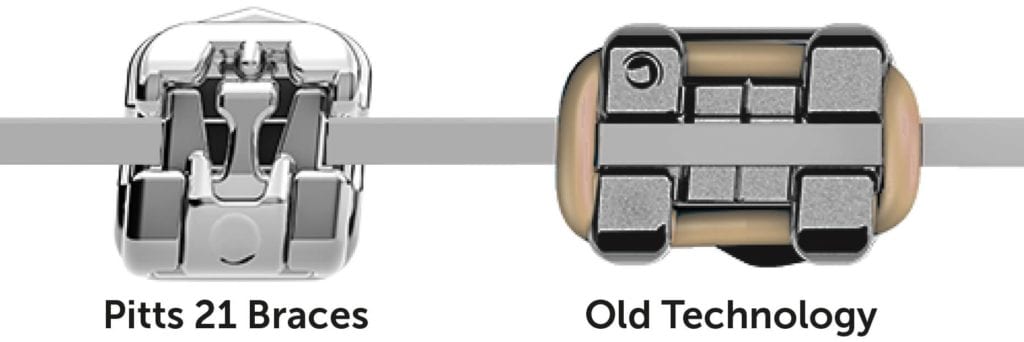Out with Traditional Braces…In with Self-Ligating Braces

Dr. Greenberg is known for being at the innovative forefront of medical advances. His goal is to provide the best possible treatment for his patients. Through routine technological updates, Dr. Greenberg has been able to not only satisfy but exceed his patients’ expectations. He thoroughly researches new technology and evaluates if it would be the best match for his patients. This is what makes him so unique. Unlike other orthodontists, Dr. Greenberg is ahead of the curve and has new and better technology at his practice.
What are Self-Ligating Braces?
Self-ligating braces are quite similar to traditional braces in general appearance and installation. The massive difference between the two is the ligature. Ligature is what binds the braces together. With conventional braces, you have to hassle with rubber bands, elastic, or metal ties. Self-ligating braces use special, spring-loaded brackets to hold archwires in place. This is more comfortable and promotes more movement.
There are numerous companies that make self-litigating braces. Dr. Greenberg uses the Damon system bracket and has recently introduced the Pitts 21 system. The Pitts 21 self-ligating system is unique in that it is the only self-ligating braces that provide 3D control earlier and throughout treatment. The Pitts 21 system makes the ingenious invention that is self-ligating braces revolutionary. But, how do they work? What does all of this mean? And, why are they worth it?
“I had the opportunity to test the Pitts 21 bracket system, which included the recommended archwire sequence. I was amazed in what I experienced which included faster and greater control with both rotation and torque and with lighter forces.”
– James Morrish D.D.S.
How do they Work?
Braces continuously apply pressure on the teeth for an extended amount of time. This pressure moves the teeth in the desired direction, slowly. The archwire, more specifically, is responsible for the movement of the teeth. With self-ligating braces, the archwires are placed in the small, spring-loaded brackets on the teeth. Once the wires are in place, the brackets are locked shut. Due to there being no elastics or rubber bands present, the need to visit the orthodontist for tightening is eliminated. Self-ligating braces and traditional braces work the same way, but there are pros and cons to both.
Pros
- Less Chair Time
Self-ligating braces take less time to insert and remove, which means less time in the orthodontic chair. Conventional braces have to be tightened due to the rubber bands or elastic losing its stretch. Because self-litigating braces like Pitts 21 use metal brackets, there are no tightening appointments. This saves you a lot of time and, more importantly, money. - Easier Cleaning
The rubber bands and elastics used in traditional braces are notorious for entrapping food. Plaque build up is definitely not something you ever want. If you have braces, it is even more important that you keep your teeth clean. Ironically though, they often times are much tougher to clean when you have braces. Self-ligating braces do not have those pesky rubber bands or elastics that make cleaning your teeth much more difficult. - Appearance
Your braces are going to be there no matter what, but their appearance does not need to be as eye-catching. While your teeth cannot be colorful with self-ligating braces, self-ligating braces can be clear, which may be better. They can also be smaller, sometimes. - Braces off Quicker
Self-ligating braces can be able to dramatically reduce the amount of time needed to wear braces. As soon as someone gets their braces on, they cannot wait to get them off. While it depends on a case by case basis, using a product like the Pitts 21 system may be worth it if only for the possible shortening of wear time.
Cons
- Slightly Higher Cost
Predictably, self-ligating braces can cost more than traditional braces. However, you have to come into the orthodontist less frequently, thus resulting in the price balancing out. The good news is, many insurance companies cover self-ligating braces! - Slight Adjustment Period
It is expected that your mouth will be irritated after having braces put in. Self-ligating braces can actually be more comfortable than classic braces. Nonetheless, there will be an adjustment period, and your mouth probably will not feel too great. This is normal. Eventually, your mouth will adjust, and you will get used to them. - Appearance
Self-ligating braces tend to look better than traditional braces, because of the smaller brackets and no elastic bands or ties. However, you will be able to see the wires no matter what, same as with traditional braces.
“Self-ligating bracket systems displayed a significantly lower level of frictional resistance, dramatically less chair-time for archwire removal and insertion, and promoted improved infection control, when compared with polyurethane elastomeric and stainless steel tie wire ligation for ceramic and metal twin brackets.”
– a study conducted by The American Journal of Orthodontics and Dentofacial Orthopedics
Types of self-ligating brackets
There are two types of self-ligating brackets: passive and active.
- Passive: Passive self-ligating brackets allow your teeth to have much freer movement due to the thinness of the archwires. This creates less tension. Often times, passive self-ligating braces are used at the beginning of treatment. This is to get the teeth to start moving. Passive treatment is used to get your teeth used to the movement and braces instead of throwing your mouth into the deep end.
- Active: Active self-ligating brackets utilize much thicker archwires. The archwires put a greater amount of tension on your teeth. This moves your teeth into the correct positions a great deal more vehemently than passive brackets. The results are stronger and more consistent. It is much faster and effective. Important things to keep in mind Ensuring that you keep your teeth clean is essential. It cannot be stressed enough that it is very very vital. In general, keeping your mouth healthy is quite important. But when you have braces, it is quintessential. Following what your orthodontist says is crucial to the health of your teeth.
The Pitts 21 Self-Ligating System
Dr. Greenberg has been Self-Ligating braces for a while. After much research and consultation with experts, he is now exclusively using the Pitts 21 Self-Ligating bracket system created by Dr. Tom Pitts. OC Orthodontics describes him as “a world renowned lecturer and clinician” who is “highly recognized for his continued teaching of orthodontic finishing and clinical excellence. Dr. Pitts teaches at the UNLV orthodontic department and is the founder of the well-respected Pitts Progressive Study Club and Pitts Masters’ in Finishing 2 year continuum.”
“As a practicing orthodontist and as a Pitts 21 patient, I can see firsthand the advantages of a square bracket slot. The control, speed and torque control were vastly superior as compared to my mini-twin bracket patients.”
– Dr. Jeff Haskins D.D.S., M.S., P.C.
The Pitts 21 Difference!
The Pitts 21 Self-Ligating System boasts being the “first and only self-ligating system that provides 3D control earlier and throughout treatment.” Unlike many other braces, the Pitts 21 System uses square wire finishings. Their square wire finishing uses 30-40% gentler horizontal and vertical forces compared to rectangular systems while having better control. This, in combination with the smooth rounded edges, allows them to be much more comfortable. The Pitts 21 Self-Ligating System can use as few as four wires. The fewer wires the less chair time. According to OC Orthodontics, “the Pitts 21 system progressively varies the slot from square in the anterior to rectangular in the posterior portion of the arch. This provides exceptional control of the anterior teeth while allowing for increased freedom of movement on the posterior teeth.” The Pitts 21 System being square allows for optimum torque control and freedom for movement.
Your Braces Treatment
The most important step in orthodontic treatment is to talk with an excellent doctor of whom you feel comfortable with! Listening to your doctor will give you the full scope of knowledge and allow you to make the most educated decision possible. Schedule your complimentary consultation with Dr. Greg Greenberg of RxSmile today for all of your orthodontic needs to be met. Please call 972-335-1300 (Monday through Thursday) or submit an online appointment request, and we will respond within one business day. You deserve the best orthodontic treatment possible!
